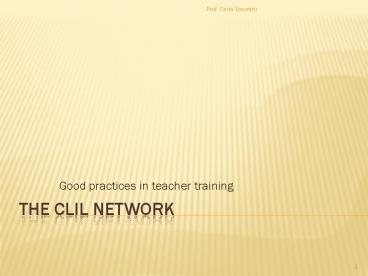THE CLIL NETWORK PowerPoint PPT Presentation
Title: THE CLIL NETWORK
1
THE CLIL NETWORK
- Good practices in teacher training
2
Foreign languages in the Italian education system
- English compulsory
- From primary to end of secondary (6 to 19)
- Junior School (11-14) two foreign languages
(English and French/Spanish/German) - Two or three foreign languages in some secondary
schools (14-19)
3
CLIL in Italy
- A lot of CLIL projects started in the 1990s,
mainly in secondary schools - New School Reform 5th year of secondary -one
subject is taught in a foreign language - Taught by subject teachers
4
Our regional and local framework
- CLIL first pioneered in technical schools (ITI
Malignani and ITC Zanon, Udine) - CLIL local network in Udine
- Regional School Authority Office encouraged
dissemination of practices and training - CLIL network in Friuli Venezia Giulia
5
Our local experience
- Province of Gorizia area of bilingualism and
minority language - 2002 a group of secondary school teachers of
English decided to set up a CLIL project in two
technical and vocational schools - Informal meetings followed to lay the foundations
of the project
6
WHY CLIL?
- Teachers expressed a wish to improve their
knowledge of English or attend English classes - Some could already speak English fluently, and
wanted to do something new in class
7
Why should I become a CLIL teacher?
- It is like starting afresh
- To enhance interaction and communication
- To foster interdisciplinarity
- To give students (and myself) the opportunity of
improving their (our) L2 skills
8
How we started
- Informal chats with colleagues during school
break to get to know their views - Non-language teachers were then asked to join the
project officially by filling in a
questionnaire - The project was then approved by most local
secondary schools which set up a network
9
Trainers tasks
- Trainers are
- L2 teachers with experience in training
- Main tasks
- Organize and run CLIL courses
- Collect resources
- Monitor and share experience
- Maintain contacts
10
Training also means
- Help learners find specific materials in L2
- Encourage colleagues to produce their own
activities - Help learners to prepare lessons
- Keep records of CLIL products
- Be ready to support colleagues
11
Who are trainees?
- Non-language teachers initial L2 test to assign
them to groups - Ideal number of trainees per course 12 - 15
- Learners competence should be at least B1
- They should be aware of what kind of long-term
involvement the project requires
12
CLIL teacher training
- Main phases
- CLIL course language and CLIL methodology course
- Self-study/group study finding resources and
materials lesson preparation - Language course abroad (LLP, Comenius)
- Subject-specific workshops
- Seminars at local and regional level
13
The long and winding roadthe training course
- Minimum 30 hours
- Both language and CLIL methodology
- Based on tasks which both develop L2 and get
students familiarize with new teaching strategies
and activities - Encourage pair and group work
- Use both language course and authentic content
materials from the beginning
14
Activities
- Reading comprehension
- Questionnaire
- True/false
- Pre-reading and while-reading discussion
- Vocabulary explain terms using L2, give
opposites/synonyms - Chart completing
15
More examples
- Reporting texts/situations
- Note taking
- Role playing
- Problem solving
- Summarizing
- Micro-lessons
- Listening comprehension
16
CLIL teacherS individual work
- Regular reading of content-related texts and
materials - Creation of specific glossary
- Development of L2 communicative skills
- Lesson preparation choice of content/creation of
activities - Self-analysis
- Regular contact with trainer and other colleagues
17
Some problems
- The CLIL teacher
- May find it unnatural using L2 afraid of
making mistakes - May feel L2 methodology too distant from his/her
own teaching habits - Tends to focus on quantity of content given
- Might feel isolated among other teachers
18
Training tips
- Have CLIL learners observe peers lessons and
fill in grids - Analyse observation grids
- Discuss in plenary after lesson
- Examine both quality of content and class
interaction - Have learners share feelings
19
The future
- Compulsory attendance of language and methodology
courses run by university - Full implementation of Secondary School Reform
- CLIL in junior and primary schools to enhance
language learning
20
- THANK YOU
- carlatoso_at_libero.it

